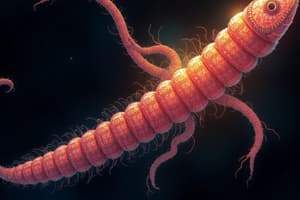Podcast
Questions and Answers
What is the primary measure to control infection caused by Taenia solium in developing countries?
What is the primary measure to control infection caused by Taenia solium in developing countries?
- Regular health check-ups for pigs
- Avoid use of human sludge as fertilizer (correct)
- Immediate vaccination of pigs
- Testing cattle for parasites before slaughter
What temperature should meats be cooked to in order to effectively kill the cysticerci of Taenia solium?
What temperature should meats be cooked to in order to effectively kill the cysticerci of Taenia solium?
- 57 °C (correct)
- 100 °C
- 75 °C
- 45 °C
What is the most serious pathology associated with human infection by Taenia solium?
What is the most serious pathology associated with human infection by Taenia solium?
- Gastrointestinal disorders
- Chronic coenurosis
- Neurocysticercosis (correct)
- Cerebral coenurosis
In which region is neurocysticercosis particularly prevalent?
In which region is neurocysticercosis particularly prevalent?
How can cysticerci in humans be diagnosed?
How can cysticerci in humans be diagnosed?
What symptoms are associated with acute coenurosis in lambs?
What symptoms are associated with acute coenurosis in lambs?
Which population is particularly susceptible to chronic coenurosis?
Which population is particularly susceptible to chronic coenurosis?
What method can significantly help reduce the prevalence of Taenia solium infection?
What method can significantly help reduce the prevalence of Taenia solium infection?
Which statement correctly describes the life cycle of Echinococcus granulosus?
Which statement correctly describes the life cycle of Echinococcus granulosus?
What type of cyst is primarily associated with cystic echinococcosis in intermediate hosts?
What type of cyst is primarily associated with cystic echinococcosis in intermediate hosts?
What can result from the rupture of hydatid cysts in humans?
What can result from the rupture of hydatid cysts in humans?
Which factor contributes most significantly to the epidemiology of cystic echinococcosis?
Which factor contributes most significantly to the epidemiology of cystic echinococcosis?
What is the primary definitive host for Echinococcus granulosus?
What is the primary definitive host for Echinococcus granulosus?
What is a common diagnostic method for detecting Echinococcus granulosus in dogs?
What is a common diagnostic method for detecting Echinococcus granulosus in dogs?
Which layer of the hydatid cyst is considered the internal germinal layer?
Which layer of the hydatid cyst is considered the internal germinal layer?
What condition can result from a large number of cysticerci in the liver parenchyma?
What condition can result from a large number of cysticerci in the liver parenchyma?
Which genotype of Echinococcus granulosus is associated with the sheep strain?
Which genotype of Echinococcus granulosus is associated with the sheep strain?
What type of disease is associated with Clostridium novyi in conjunction with cysticercosis?
What type of disease is associated with Clostridium novyi in conjunction with cysticercosis?
Which of the following is NOT an intermediate host for Echinococcus granulosus?
Which of the following is NOT an intermediate host for Echinococcus granulosus?
What is a common method for controlling coenurosis in small ruminants?
What is a common method for controlling coenurosis in small ruminants?
What is the primary clinical significance of cystic echinococcosis in humans?
What is the primary clinical significance of cystic echinococcosis in humans?
What does the adult form of Echinococcus granulosus primarily inhabit in its definitive host?
What does the adult form of Echinococcus granulosus primarily inhabit in its definitive host?
Which symptom is commonly associated with chronic infections of cysticercosis?
Which symptom is commonly associated with chronic infections of cysticercosis?
In angiosarcoma, which characteristic is true about the strain G6 of Echinococcus granulosus?
In angiosarcoma, which characteristic is true about the strain G6 of Echinococcus granulosus?
Flashcards
Hydatid cyst structure
Hydatid cyst structure
A cyst with a thick wall (two layers), containing scolices (hooks and suckers), often found in internal organs.
Hydatid sand composition
Hydatid sand composition
Free scolices and broad capsules in hydatid fluid. Microscopic scolices are armed with hooks and suckers.
Echinococcus granulosus genotypes
Echinococcus granulosus genotypes
Different strains of E. granulosus, classified by host susceptibility, with G1 (sheep) being the most impactful.
Cystic echinococcosis (CE)
Cystic echinococcosis (CE)
Signup and view all the flashcards
CE Diagnosis in dogs
CE Diagnosis in dogs
Signup and view all the flashcards
E. granulosus in dogs
E. granulosus in dogs
Signup and view all the flashcards
Control of T. solium infection
Control of T. solium infection
Signup and view all the flashcards
T. solium infection symptoms
T. solium infection symptoms
Signup and view all the flashcards
CE worldwide occurrence
CE worldwide occurrence
Signup and view all the flashcards
Intermediate hosts in CE
Intermediate hosts in CE
Signup and view all the flashcards
Neurocysticercosis
Neurocysticercosis
Signup and view all the flashcards
Epidemiology of T. solium infection
Epidemiology of T. solium infection
Signup and view all the flashcards
Diagnosis of T. solium infection
Diagnosis of T. solium infection
Signup and view all the flashcards
Cerebral coenurosis
Cerebral coenurosis
Signup and view all the flashcards
Coenurosis in lambs vs. adult ewes
Coenurosis in lambs vs. adult ewes
Signup and view all the flashcards
Epidemiology of Cerebral Coenurosis
Epidemiology of Cerebral Coenurosis
Signup and view all the flashcards
Cerebral Coenurosis Treatment in Small Ruminants
Cerebral Coenurosis Treatment in Small Ruminants
Signup and view all the flashcards
Hepatitis Cysticercosa
Hepatitis Cysticercosa
Signup and view all the flashcards
Echinococcus spp. Intermediate Hosts
Echinococcus spp. Intermediate Hosts
Signup and view all the flashcards
Echinococcus spp. Definitive Hosts
Echinococcus spp. Definitive Hosts
Signup and view all the flashcards
Echinococcus granulosus Adult Stage
Echinococcus granulosus Adult Stage
Signup and view all the flashcards
Echinococcus Life Cycle stages
Echinococcus Life Cycle stages
Signup and view all the flashcards
Hydatid Cyst Location
Hydatid Cyst Location
Signup and view all the flashcards
Study Notes
Cestodes (Tapeworms)
- Cestodes are tapeworms.
- Genera: Taenia spp. and Echinococcus spp.
Taenia spp.
-
T. saginata
- Humans are the definitive host.
- Worldwide distribution.
- Adult length: 5-10 meters
- Intermediate host: Cattle
- Larval stage: Cysticercus bovis
- Larva site in intermediate host: Muscles
- Larva morphology: Small (1 cm), fluid-filled cyst with a single invaginated scolex (4 suckers).
-
T. solium
- Humans are the definitive host.
- Worldwide distribution, except for Latin America, Africa, and Asia.
- Adult length: 5 meters
- Intermediate host: Pigs and humans.
- Larval stage: Cysticercus cellulosae
- Larva site in intermediate host: Muscles
- Larva morphology: Similar to T. saginata in size and shape, but with an armed rostellum.
-
T. ovis
- Dogs are the definitive host
- Worldwide distribution.
- Adult length: 2 meters.
- Intermediate host: Sheep
- Larval stage: Cysticercus ovis
- Larva site in intermediate host: Muscles
- Larva morphology: Small (0.5 cm), fluid-filled cyst with a single invaginated scolex and armed rostellum
-
Hydatigena
-
Dogs are the definitive host.
-
Worldwide distribution.
-
Adult length: 5+ meters
-
Intermediate host: Sheep, goat, buffalo, camel, pig, rabbit
-
Larval stage: Cysticercus tenuicollis
-
Larva site in intermediate host: Liver, peritoneum, mesentery
-
Larva morphology: Large (up to 8 cm in diameter). Fluid filled cyst with single invaginated scolex.
-
Other Taenia spp.: T. multiceps, T. serialis, T. pisiformis, T. taeniformis
-
-
Macroscopic Morphology
- T. saginata: 5-10 meters long, large segmented tapeworm.
- T. solium: 3-7 meters long, large segmented tapeworm.
- T. multiceps, T. serialis, T. hydatigena, T. ovis, T. pisiformis, T. taeniformis: Varying lengths
-
*Scolex Morphology for Taenia saginata and Taenia solium
-
T. saginata: Relatively large (1.5 mm in diameter), 4 cup-shaped muscular suckers, and no rostellum or hooks.
-
T. solium: Relatively small (0.6-1 mm in diameter), 4 cup-shaped muscular suckers, rostellum armed with double rows of hooks.
Taenia spp. Mature Segments
- Nearly squarish or slightly broader segments.
- One set of genital organs.
- Irregularly alternating common genital pores.
- Numerous testes (300-400).
- Bilobed ovaries and Mehlis gland between the lobes.
- Vitelline glands behind the ovaries forming a compact mass.
- Uterus is a simple tube extending anteriorly in the median plane.
- Gravid Segments:
- T. saginata have longer, broader segments with 15-20 lateral uterine branches.
- T. solium have longer than broad segments, with 7-12 lateral uterine branches.
Taenia spp. Life Cycle
- Humans can become infected by eating undercooked or raw infected meat.
- Oncospheres hatch, penetrate intestinal wall, and migrate to muscles.
- Cysticerci develop in muscles of intermediate hosts.
- Humans become infected by ingesting raw or undercooked infected meat.
- Eggs or gravid proglottids are passed into the environment.
Taenia spp. Eggs
- Small in size (35-45 µm)
- Globular or spherical in shape.
- Brownish in color.
- Embryophore (double contoured, radially striated) containing a hexacanth embryo.
Cysticercus spp. (Larval Forms)
-
Cysticercus bovis: Spindle-shaped, cream-white cysts in cattle muscles.
-
Cysticercus cellulosae: Spindle-shaped, cream-white cysts in pig muscle and human tissues potentially leading to neurocysticercosis.
-
Cysticercus tenuicollis: Large bladder-like cyst in ruminants (sheep, goats, cattle).
-
Strobilocercus fasciolaris: Small vesicle or cyst in rat and mice liver containing a segmented neck with invaginated scolex.
-
Coenurus cerebralis: Large fluid-filled cyst in sheep and other ruminants' brain & spinal cord.
Echinococcus spp.
-
Echinococcus granulosus:
- Definitive host: Dogs
- Intermediate host: Ruminants (e.g., sheep, cattle) and humans
- Larval stage: Hydatid cyst (in lungs, liver)
- Site in definitive host: Small intestine
- Site in intermediate host: Any organ of the host body (often the lung and liver).
-
*Adult E. granulosus (Scolex and strobila)
-
Scolex is small with 4 suckers and a rostellum with 2 crowns of hooks, strobila has 3-4 (usually 3) segments; one immature, one mature, one gravid.
-
Mature segment is longer than broad and has a horse-shoe shaped ovary found posteriorly and has Vitelline glands in a compact mass behind it.
-
Gravid segment is longer than broad and has a longitudinal uterus with 12-15 main lateral pouches containing eggs.
-
Life Cycle (of E. granulosus):
- Dogs defecate eggs into environment.
- Intermediate hosts (e.g., sheep, cattle) ingest eggs.
- Oncospheres develop into hydatid cysts in organs (e.g., lungs, liver).
-
Echinococcus multilocularis:
- Definitive host: Dogs,
- Intermediate host: Rodents and possible humans
- Larval stage: Alveolar cyst
- Location: Lungs and liver. Fatal disease in humans, similar to cancer
Echinococcus granulosus
- Infective to humans through ingestion of eggs or gravid proglottids.
- Infections in humans are asymptomatic in the majority of cases (in dogs and pigs)
- Development of large hydatid cysts in organs (lungs, liver) causes problems.
- Can cause anaphylactic shock in susceptible individuals due to cyst rupture.
Pathology, Epidemiology, and Control of Echinococcus spp.
- Pathogenesis (various species)
- Epidemiology (various species)
- Diagnosis (various species)
- Control (for species and infections)
Studying That Suits You
Use AI to generate personalized quizzes and flashcards to suit your learning preferences.



